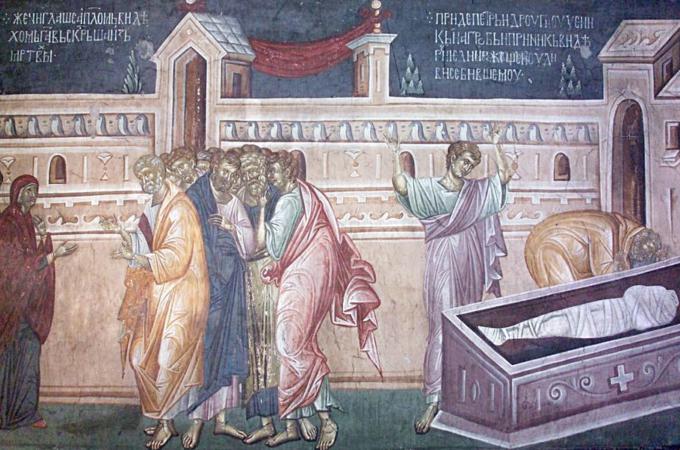A verdict which demands no evidence
It's a Scripture which the Church leaves us free to speculate about: "When Simon Peter arrived after him, he went into the tomb and saw the burial cloths there, and the cloth that had covered his head, not with the burial cloths but rolled up in a separate place. Then the other disciple also went in, the one who had arrived at the tomb first, and he saw and believed." (Jn. 20:1-8)
When you heard these verses on Easter morning, did you wonder what about the cloths that caused John to believe? Did Jesus perhaps fold cloths in some characteristic way? Or did John, from his special bond with Christ, just "see" that the Resurrection made sense, when it hit him that the body was really not there?
You probably did not arrive at St. Augustine's interpretation, who wrote that John did not come to believe in the Resurrection at all: what he "saw and believed" was that Mary Magdalene was right, when she reported, "They have taken the Lord from the tomb." Any other interpretation, Augustine argues, is ruled out by the words which follow immediately, "For they did not yet understand the Scripture that he had to rise from the dead" (Jn 20:9). If John had believed then in the Resurrection, surely, he would have understood the Scripture.
Yet one might reasonably disagree with Augustine, on two grounds. First, when New Testament writers use "to believe" absolutely, not giving an object (as in, believing in someone), it typically means a supernatural act of faith in Christ. And so here. On Augustine's interpretation, an object would be expected, such as "He saw and believed what Mary had said."
This argument attains even more force if one considers that the person last referred to, before this verse about John's belief, is Christ: in verse 7 we are told that John saw "the cloth that had covered his head," that is, the Lord's head. So in the context the Lord, not Mary Magdalene, is more naturally the object of John's belief.
A second argument is stronger. I like to tell my students that classical writers differ from modern in that we moderns put the premises first, before the conclusion, whereas classical writers give the conclusion first, and afterwards supply the reasons. The standard form for an argument in a classical writer is: "Evidently, . . . ; for, . . . ; for, . . . ;" and so on, where the "for" clauses give the premises. (Not a mere difference in style, the preference of classical writers is connected with their naïve "realism," as contrasted with our preoccupation with the subject.)
I also tell my students is that a "for" clause in a classical writer need not be giving a reason for what immediately precedes. Sometimes it "reaches back" to a much earlier sentence or supplies a presupposition governing an entire passage.
And so it is here, I think. The assertion, "For they did not yet understand the Scripture that he had to rise from the dead," is not meant to give the reason for "he saw and believed." (It would have been in the singular then: "John saw and believed Mary, because he did not yet understand the Scripture.") Rather, it reaches back and explains why Peter and John bothered to run to the tomb at all. It supplies a presupposition which to a later Christian reader makes the whole episode intelligible.
Why after all didn't Mary the Mother of God, who stood faithfully at the foot of the Cross, go to the tomb with the other women, or even before them? Pious writers have speculated: because this same woman, who was so familiar with Scripture that she could improvise the Magnificat from contemplating Hannah's song, did not need to go to the tomb. She saw in faith already, and understood from Scripture, that He would be raised.
The Jews who converted in Jerusalem through St. Peter's preaching (the reading for Easter Monday) also did not have to run to the tomb. Apparently they understood well enough, and accepted in faith what Peter explained to them, when he quoted the Septuagint translation of Psalm 16, "you will not abandon my soul to the netherworld, nor will you suffer your holy one to see corruption."
Who knows if some Greeks in the crowd had reached the same conclusion, not from Scripture, of course, but by natural reason, guided perhaps by what the Lord had said a short time earlier, "The hour has come for the Son of Man to be glorified. Amen, amen, I say to you, unless a grain of wheat falls to the ground and dies, it remains just a grain of wheat; but if it dies, it produces much fruit" (Acts 12:23-24). Of course, wheat which falls to the ground and dies, springs up again as a new plant. A pagan who believed upon Peter's preaching that what was celebrated in myths about the "Corn God" had taken place in actual history (as C.S. Lewis and G.K. Chesterton believed much later), would similarly feel no need to go to the tomb and examine it.
John in his characteristic humility was, as it were, apologizing for not being the best exemplar of Christian belief. In this matter of faith, we have an advantage even over the apostles: "Blessed are those who have not seen and have believed."
- Michael Pakaluk is Professor of Ethics and Social Philosophy in the Busch School of Business at The Catholic University of America. His book on the gospel of Mark, ‘‘The Memoirs of St. Peter,’’ is available from Regnery Gateway.



















